Electric car charging can be a daunting topic for new EV owners, with various options and technical terms to navigate.
At Smart-Motoring.com, we simplify the complexities and explain everything you need to know. As electric vehicles revolutionise transportation, offering a cleaner and more sustainable alternative to traditional cars, understanding how to manage your EV charging effectively is crucial.
Whether you’re looking to install an electric car charger at home, optimize your car battery life, or plan a long journey, this guide covers all the essentials. From home EV charging solutions to navigating public charging networks, we’ve got you covered on every aspect of electric car charging.
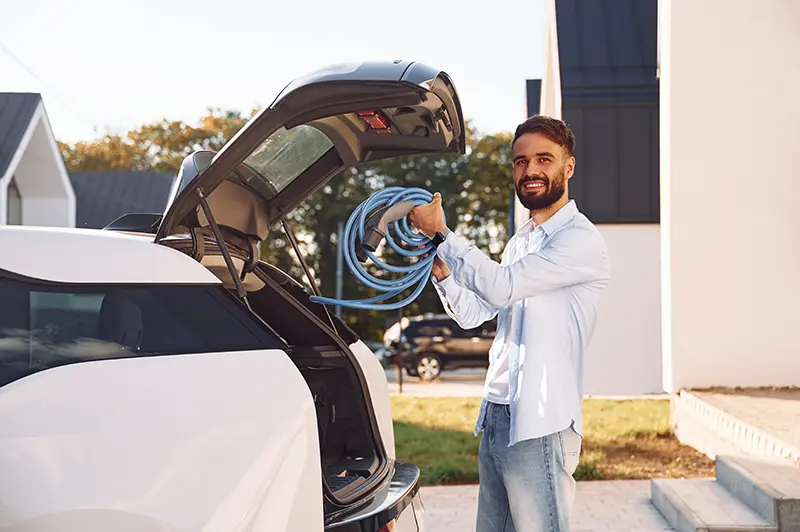
Electric Car Charging: Your Essential Guide to Fast and Easy EV Charging
- What is Electric Car Charging?
- Why Electric Car Charging is Crucial
- Home Charging: The Convenient Choice
- Choosing the Right Home Charger
- Installation of a Home Charger
- Benefits of Home Charging
- Understanding Electric Car Batteries
- Types of Electric Car Batteries
- Maximizing EV Battery Life
- When to Charge Your EV
- Optimal Charging Times
- Understanding Charging Speeds
- Fast Charging Explained
- Planning a Long Journey with an EV
- Mapping Out Charging Stations
- Public Charging Stations: What You Need to Know
- Types of Public Charging Stations
- Using Public Charging Stations
- EV Charging Costs: What to Expect
- Saving Money on EV Charging
- Charging Etiquette: Sharing the Road
- Understanding EV Charging Connector Types
- Popular EV Charging Connector Types
- EV Charging at Work: A Growing Trend
- Installing Workplace Charging Stations
- EV Charging Infrastructure: The Future
- Government Incentives for EV Charging
- Range Anxiety: What It Is and How to Overcome It
- Electric Car Range: How Far Can You Go?
- Extending Your Electric Car’s Range
- Charging Your EV in Cold Weather
- Preparing Your EV for Winter
- Public Charging in Cold Weather
- EV Charging for Apartment Dwellers
- Portable EV Chargers: Charging on the Go
- Understanding EV Charging Networks
- How to Choose the Right Charging Network
- EV Charging Apps: Your Best Friend on the Road
- Safety Tips for EV Charging
- Regular Maintenance of Your EV Charger
- Understanding the Environmental Impact of EV Charging
- The Future of EV Charging Technology
- Ultra-Fast Charging: The Next Big Thing
- Wireless EV Charging: The Ultimate Convenience
- Understanding the Cost of Installing a Home Charger
- Can You Charge an EV with Solar Power?
- Integrating Solar Power with EV Charging
- EV Charging Myths Debunked
- Public Charging vs. Home Charging: Which is Better?
- What to Do If You Can’t Charge at Home
- The Role of EV Charging in Reducing Emissions
- Understanding Time-of-Use Rates for EV Charging
- How to Avoid Overloading Your Home’s Electrical System
- The Importance of Professional Installation for Home Chargers
- Upgrading Your Home’s Electrical System for EV Charging
- The Economics of EV Charging: Cost vs. Petrol
- EV Battery Swapping: An Alternative to Charging?
- The Role of Government Policies in EV Charging Infrastructure
- The Future of EV Charging: Trends to Watch
What is Electric Car Charging?

Electric car charging refers to the process of replenishing the battery in an electric vehicle using electricity. This can be done through home EV charging, at work, or at public charging stations.
With the growing popularity of electric cars, understanding the different charging options is crucial. Whether you’re using a home charging point or an EV charging station, knowing how to efficiently charge your vehicle is key to maintaining your car’s performance and extending battery life.
Why Electric Car Charging is Crucial
Charging your electric car is fundamental to your ability to drive, as EVs rely entirely on electricity to function. Unlike traditional vehicles that can refuel quickly at petrol stations, EVs require access to electric car charging points to stay powered.
The availability of an electric car charger at home or nearby public chargers significantly impacts your daily driving habits and long-distance travel plans.
Without proper charging infrastructure, the benefits of driving an electric vehicle could be compromised, making charging a critical aspect of EV ownership.
Home Charging: The Convenient Choice
Home EV charging offers the most convenient solution for keeping your EV ready for the road. Installing a home charging point means you can recharge your vehicle overnight, ensuring it’s fully charged every morning.
The convenience of charging your car at home cannot be overstated, especially when considering the potential savings on fuel costs compared to petrol or diesel.
With options like the 7kW home charger, you can efficiently power up your vehicle while taking advantage of lower electricity rates during off-peak hours.
Choosing the Right Home Charger
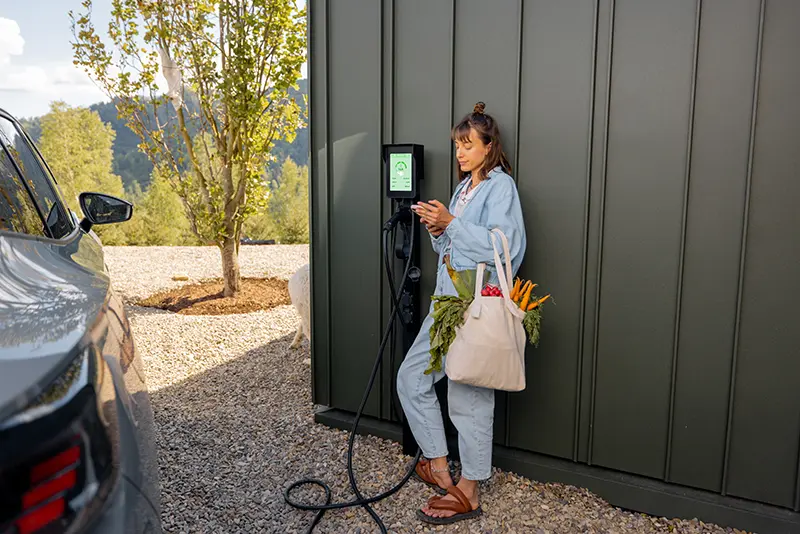
Selecting the right home EV charger depends on your vehicle’s battery capacity and your daily charging needs.
Level 2 chargers, such as the Pod Point, are popular for home use due to their balance of charging speed and affordability.
When choosing an electric car charger at home, consider factors like the charging system, power ratings, and whether your home’s electrical system can support the installation.
The right home charger not only ensures efficient charging but also optimizes your vehicle’s performance and extends the lifespan of your car battery.
Installation of a Home Charger
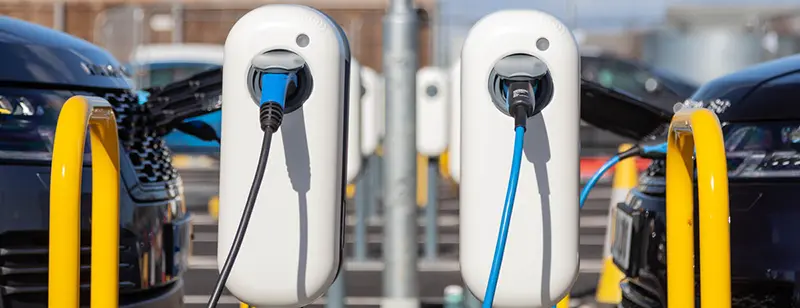
Installing a home charger requires the expertise of a professional electrician to ensure safety and compliance with local regulations.
The installation process involves assessing your home’s electrical capacity, selecting a suitable location for the charger, and securely connecting it to your electrical system.
For those eligible, the Electric Vehicle Home Charge Scheme (OZEV) provides grants to help offset installation costs, making it easier and more affordable to set up a home charging point. Proper installation is crucial for avoiding issues like overloading your electrical system and ensuring the longevity of your charging equipment.
Benefits of Home Charging
Home charging offers numerous benefits, including cost savings, convenience, and the ability to charge your vehicle at any time. Charging your car at home allows you to avoid the hassle of finding available charging points, especially during peak hours.
Additionally, home EV charging can be more economical than relying on public chargers, particularly if you charge during off-peak times. Over time, these savings add up, making home charging an attractive option for most EV owners.
Understanding Electric Car Batteries
The battery is the heart of your electric vehicle, and understanding how it works is essential for maximizing your car’s performance. Most EVs use lithium-ion batteries, known for their efficiency, long lifespan, and ability to provide substantial driving range.
Properly managing your battery, from regular charging to maintaining optimal temperatures, can significantly extend your car battery life and ensure reliable performance. Knowing the basics of how your battery operates also helps you make informed decisions about charging, whether at home or using a public charger.
Types of Electric Car Batteries
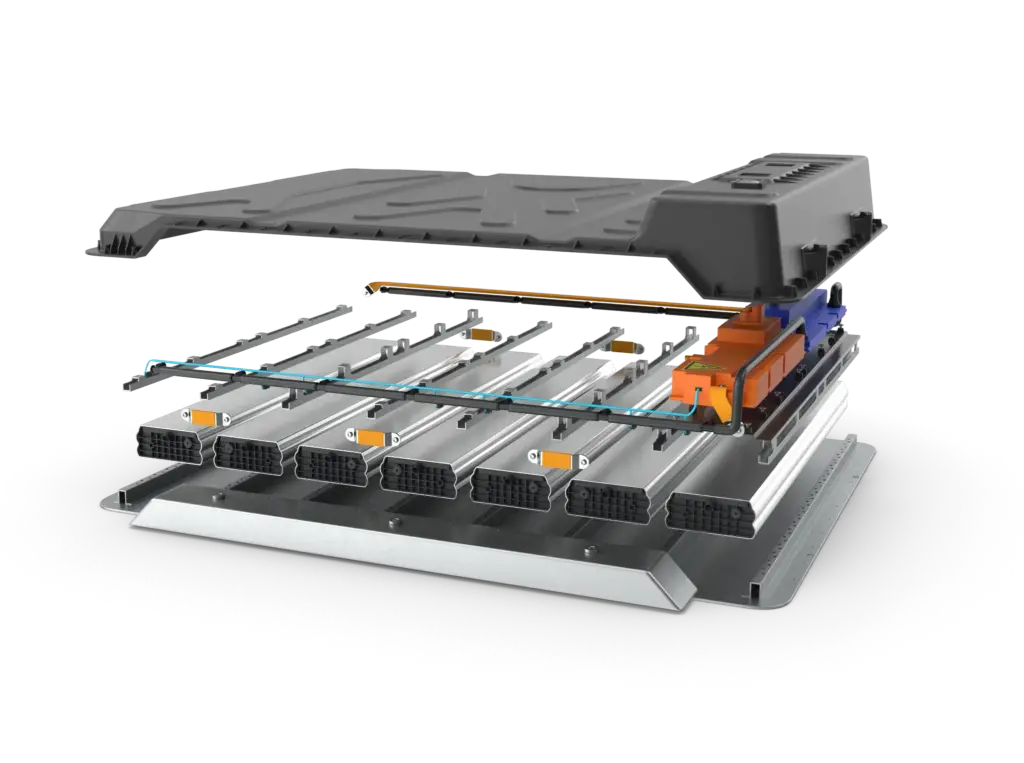
Maximizing EV Battery Life
Lithium-ion batteries are the most common type found in modern EVs, valued for their energy density, durability, and relatively low cost. These batteries offer a good balance between performance and longevity, making them ideal for both daily commuting and long-distance travel.
Understanding the specific battery type in your vehicle can help you choose the right charging methods and ensure you’re using the most effective strategies to prolong battery life and maintain optimal performance.
To maximize the life of your EV battery, avoid fully draining it or charging it to 100% regularly. Instead, try to keep the charge between 20% and 80%, as this range is less stressful on the battery. Frequent short charging sessions are better than letting the battery drain completely before recharging.
Additionally, using home EV charging points during off-peak hours can reduce the strain on your battery and improve overall efficiency. With proper care, your EV battery can last for many years, reducing the need for costly replacements.
When to Charge Your EV
Knowing the right time to charge your EV can have a significant impact on both battery life and your driving experience. For most drivers, charging at home overnight is the most convenient option, as it takes advantage of lower electricity rates.
Charging when your battery level is between 20% and 80% is generally recommended to avoid putting unnecessary stress on the battery. Planning your charging schedule around your driving habits and energy costs ensures that your vehicle is always ready to go when you need it.
Optimal Charging Times
Charging your EV during off-peak hours, typically at night, not only saves money but also reduces strain on the electrical grid.
This practice is both economically and environmentally beneficial, as it helps balance energy demand and reduces the likelihood of overloading the grid. By charging at optimal times, you can take full advantage of your home charging system, ensuring your vehicle is fully charged and ready for your next journey.
Understanding Charging Speeds
Charging speeds vary based on the type of charger you use. Level 1 chargers, which plug into a standard household outlet, are the slowest but most accessible option. Level 2 chargers, like those commonly used for home EV charging, offer faster charging times and are ideal for daily use.
For rapid charging, DC fast chargers provide a significant amount of charge in a short time, making them ideal for long trips. Understanding the different charging speeds and their impact on battery life helps you choose the best charging option for your needs.
Fast Charging Explained
Fast chargers, or Level 3 chargers, can rapidly recharge your EV’s battery, often delivering up to 80% charge in under 30 minutes. While convenient for long trips, frequent use of fast charging can reduce your battery’s lifespan due to the higher heat generated during the process.
Therefore, it’s best to use fast chargers sparingly and rely on slower home EV charging for regular use. Understanding the trade-offs between charging speed and battery health is crucial for maintaining your vehicle’s performance and longevity.
Planning a Long Journey with an EV
Long-distance travel in an EV requires careful planning, as you need to account for charging stops along your route. Unlike conventional vehicles that can refuel quickly at petrol stations, EVs depend on available charging points, which may be less frequent in rural areas.
Using tools like EV route planners or apps can help you locate charging stations, including those with DC fast chargers, ensuring you don’t run out of power mid-journey. By planning ahead, you can enjoy your trip without the stress of finding a charging station at the last minute.
Mapping Out Charging Stations
Before setting out on a long journey, it’s essential to map out your route and identify charging stations along the way. Many apps and online tools can help you find both public chargers and rapid chargers, making it easier to plan your stops.
Consider the type of charging station available, as different connectors may be required depending on your vehicle. With a well-planned route, you can minimize downtime and ensure a smooth, uninterrupted journey.
Public Charging Stations: What You Need to Know
Public charging stations are vital for EV drivers who travel long distances or don’t have access to home charging. These stations range from slow Level 1 chargers to fast DC chargers, each catering to different charging needs. Knowing how to use public charging points, including payment methods and network access, is essential for any EV owner.
As the infrastructure for EVs continues to grow, public charging stations will become more widespread, making it easier than ever to keep your vehicle charged on the go.
Types of Public Charging Stations
Public charging stations come in various types, from basic Level 1 chargers to advanced DC fast chargers. Understanding the differences between these options helps you choose the right station based on your needs. For instance, Level 2 chargers are suitable for longer stops, while fast chargers are ideal when you’re in a hurry.
Additionally, some public chargers may require a membership or payment through an app, so it’s important to be prepared before you arrive.
Using Public Charging Stations
Using a public charging station is straightforward, but it’s important to familiarize yourself with the process before you hit the road. Most stations require you to set up an account with the charging network or use a compatible app.
Payment methods vary, with some stations offering contactless payment, while others may require a subscription. Knowing how to navigate these options ensures a hassle-free charging experience, whether you’re on a long road trip or simply topping up your battery.
EV Charging Costs: What to Expect
The cost of charging your EV can vary depending on where and how you charge. Home charging is generally more cost-effective, especially when using a 7kW home charger during off-peak hours. Public charging stations, particularly those offering fast charging, may have higher rates, so it’s important to plan accordingly. Some workplaces and public areas offer free or discounted charging, providing additional savings.
By understanding the costs associated with different charging options, you can better manage your EV’s operating expenses.
Saving Money on EV Charging
To minimize your EV charging costs, take advantage of off-peak electricity rates and look for free or discounted public chargers. Many energy providers offer time-of-use rates that reduce the cost of charging during certain hours, typically at night.
Additionally, using a home EV charging point can save money compared to relying on public stations. By being strategic about when and where you charge, you can significantly reduce your overall charging expenses.
Charging Etiquette: Sharing the Road
As more drivers switch to EVs, understanding and practicing good charging etiquette becomes increasingly important. Always move your vehicle once it’s fully charged to allow others to use the station. Avoid unplugging someone else’s car unless you have permission or it’s an emergency.
Respecting these unwritten rules helps create a positive experience for all EV drivers and ensures that available charging points are used efficiently.
Understanding EV Charging Connector Types
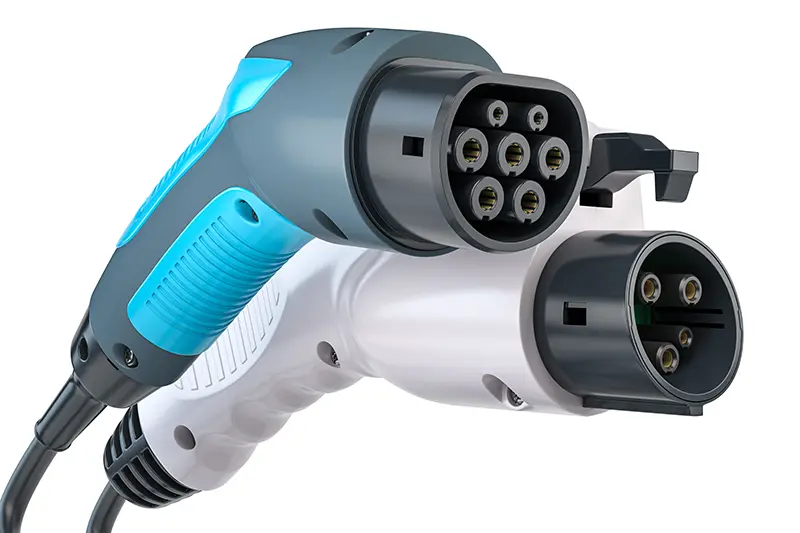
EVs use various types of connectors for charging, and it’s important to know which one your vehicle requires. Common connectors include Type 1 (J1772) and Type 2 (Mennekes) for AC charging, and CCS and CHAdeMO for DC fast charging.
Tesla vehicles have their own proprietary connector but can use adapters for other charging networks. Familiarizing yourself with the different connectors ensures you can access the right charging stations, whether at home or on the road.
Popular EV Charging Connector Types
The most widely used EV charging connectors include Type 1, Type 2, CCS, and CHAdeMO. Type 1 connectors are common in North America, while Type 2 connectors are more prevalent in Europe. CCS (Combined Charging System) is gaining popularity due to its compatibility with both AC and DC charging, making it a versatile choice for many drivers.
Knowing which connector your vehicle uses helps you identify compatible charging points, whether you’re using a home EV charger or a public station.
EV Charging at Work: A Growing Trend
Many workplaces are now offering EV charging stations as a perk for employees, making it easier to charge your car while at work.
This trend not only benefits employees but also supports the wider adoption of electric vehicles. For employers, installing charging stations can enhance their eco-friendly credentials and attract environmentally conscious workers.
If home charging isn’t an option, workplace charging can be a convenient alternative, ensuring your car is ready to go at the end of the day.
Installing Workplace Charging Stations
For businesses, installing EV charging stations can provide a valuable service to employees and customers alike. The installation process involves assessing the site’s electrical capacity, choosing the right charging equipment, and ensuring compliance with local regulations.
Government grants, such as those offered by the Electric Vehicle Home Charge Scheme, can help offset installation costs. By providing workplace charging, businesses can support the transition to electric vehicles and promote sustainability.
EV Charging Infrastructure: The Future
The expansion of EV charging infrastructure is crucial for the widespread adoption of electric vehicles. As more charging stations become available, range anxiety will diminish, making EVs a more viable option for all drivers. Investments in infrastructure, such as BP Pulse and other major networks, are driving the growth of charging points across cities and rural areas alike.
As technology advances, we can expect to see faster, more efficient charging options, including ultra-fast chargers and wireless charging systems, becoming the norm.
Government Incentives for EV Charging
Governments around the world are offering incentives to promote the adoption of electric vehicles and the installation of charging infrastructure.
These incentives include grants for installing home and workplace chargers, tax credits for purchasing EVs, and funding for expanding public charging networks.
Programs like the Electric Vehicle Home Charge Scheme (OZEV) make it more affordable for individuals and businesses to install charging points, supporting the transition to a cleaner, more sustainable transportation system.
Range Anxiety: What It Is and How to Overcome It
Range anxiety, the fear of running out of battery before reaching a charging station, is a common concern among new EV owners. However, with proper planning and an understanding of your vehicle’s range, this anxiety can be easily managed.
Using route planners and charging apps, you can ensure you always have access to available charging points along your journey. As charging infrastructure continues to grow, range anxiety is becoming less of an issue, making EVs a more appealing option for long-distance travel.
Electric Car Range: How Far Can You Go?
The range of an electric car varies depending on factors such as battery size, driving conditions, and driving habits. Most modern EVs offer ranges between 150 to 300 miles on a full charge, with some models, like the Tesla Model S, exceeding 370 miles.
Understanding your vehicle’s range capabilities helps you plan trips and manage charging stops effectively. By driving efficiently and using power-hungry features sparingly, you can maximize your car’s range and reduce the frequency of charging.
Extending Your Electric Car’s Range
To extend your electric car’s range, practice efficient driving habits, such as smooth acceleration and braking, and minimize the use of air conditioning and other energy-intensive features.
Reducing unnecessary weight in your vehicle and maintaining proper tire pressure can also improve range. For longer trips, planning your route to include charging stops at strategic locations ensures you can travel further without the risk of running out of power.
By understanding and optimizing these factors, you can get the most out of your electric vehicle.
Charging Your EV in Cold Weather
Cold weather can affect your EV’s battery performance and charging speed, making it important to plan for longer charging times and potentially reduced range during winter months.
To mitigate these effects, precondition your battery by warming it up while still plugged in, and avoid charging to 100% in extremely cold conditions.
Using a home EV charger with a built-in heating feature can also help maintain optimal battery temperature. By taking these precautions, you can ensure your EV performs reliably even in cold weather.
Preparing Your EV for Winter
Preparing your EV for winter involves a few key steps, such as preconditioning your battery and adjusting your driving habits to account for reduced range. Charging your car at home before heading out in cold weather ensures the battery is warm and ready for use.
Additionally, reducing the use of heating and other power-intensive features can help conserve battery life during winter months. Proper winter preparation not only ensures your car runs smoothly but also extends the overall life of your battery.
Public Charging in Cold Weather
In cold weather, public fast chargers can be particularly useful, as they help warm the battery during the charging process, improving efficiency and reducing charging time.
When planning a winter trip, include stops at fast chargers to ensure your vehicle remains warm and charged throughout the journey. Some charging stations offer heated shelters or amenities to make the wait more comfortable.
By planning your route with cold weather in mind, you can avoid potential issues and keep your EV running smoothly.
EV Charging for Apartment Dwellers
For apartment dwellers, charging an EV can be more challenging than for those with a private garage or driveway. However, many apartment buildings are now installing dedicated EV charging spots to accommodate the growing number of electric vehicles. If your building doesn’t have charging facilities, consider petitioning your landlord or homeowners’ association to install a charging station.
Portable EV chargers are also an option, allowing you to charge your car using a standard outlet, though at a slower rate.
Portable EV Chargers: Charging on the Go
Portable EV chargers provide flexibility for drivers who need to charge their vehicles in locations without dedicated charging stations.
These chargers can plug into a standard household outlet or a more powerful socket, depending on the model. While they offer slower charging speeds compared to fixed stations, they’re a valuable tool for emergencies or when traveling to areas with limited charging infrastructure.
By carrying a portable charger, you can ensure you’re always able to top up your battery, no matter where you are.
Understanding EV Charging Networks
EV charging networks are groups of charging stations operated by a single company or organization. These networks often require a membership or app to access their stations, and they may offer different pricing structures, including pay-per-use or subscription models.
Major networks like BP Pulse, Tesla Superchargers, and OZEZ are expanding rapidly, making it easier for drivers to find and use available charging points. Understanding the networks in your area ensures you have reliable access to charging wherever you go.
How to Choose the Right Charging Network
When selecting an EV charging network, consider factors like the availability of stations in your area, the cost of charging, and any membership requirements.
Some networks offer extensive coverage with a large number of stations, while others may provide lower prices or additional perks. It’s also important to consider the types of chargers available, such as rapid chargers or DC fast chargers, depending on your needs.
By choosing the right network, you can ensure a seamless charging experience whether you’re at home or on the road.
EV Charging Apps: Your Best Friend on the Road
EV charging apps are essential tools for any electric vehicle owner, helping you locate charging stations, check real-time availability, and even start charging sessions remotely. These apps can also provide valuable information about charging costs, station compatibility, and nearby amenities.
By using an EV charging app, you can easily plan your trips, avoid long waits at busy stations, and ensure you always have enough charge to reach your destination. With the right app, managing your EV charging becomes a simple and stress-free process.
Safety Tips for EV Charging
Safety should always be a priority when charging your EV, whether at home or using a public station. Ensure your home charger is installed by a professional to prevent potential hazards like electrical fires. Avoid charging in wet conditions and regularly inspect your charging cables for any signs of wear and tear.
Following the manufacturer’s guidelines for your specific charging equipment helps ensure safe and efficient operation. By taking these precautions, you can enjoy the benefits of EV ownership without compromising on safety.
Regular Maintenance of Your EV Charger
Just like your EV, your home charger requires regular maintenance to ensure it functions properly and safely. Periodically check the charger and cables for any damage or wear, and keep the area around the charger clean and free from debris.
If you notice any issues, contact a professional for repairs to prevent potential hazards. Proper maintenance not only extends the life of your charger but also ensures it operates efficiently, providing reliable power for your vehicle whenever you need it.
Understanding the Environmental Impact of EV Charging
Charging your EV has a significantly lower environmental impact than fueling a traditional gasoline car, especially when using renewable energy sources. By opting for a home EV charger powered by solar panels or a green energy plan from your utility provider, you can further reduce your carbon footprint.
However, the production and disposal of EV batteries do have environmental implications, so it’s important to consider the full lifecycle of your vehicle. By making informed choices about how you charge and maintain your EV, you can minimize its environmental impact.
The Future of EV Charging Technology
The future of EV charging technology is bright, with advancements like ultra-fast charging, wireless charging, and smart grid integration on the horizon.
Ultra-fast chargers, capable of providing hundreds of miles of range in just minutes, are expected to become more widespread, reducing charging times and making EVs even more convenient.
Wireless charging, which allows you to charge your car simply by parking over a special pad, could revolutionize the way we think about EV charging. As these technologies develop, the EV charging experience will become faster, easier, and more integrated into our daily lives.
Ultra-Fast Charging: The Next Big Thing
Ultra-fast chargers represent the cutting edge of EV charging technology, offering the ability to recharge your vehicle’s battery in a fraction of the time it currently takes.
These chargers use high-power DC charging to deliver a rapid boost of energy, making them ideal for long-distance travel or quick top-ups.
While they are not yet as widespread as other types of chargers, the infrastructure is growing, and many experts believe that ultra-fast charging will soon become the standard for EVs. This technology will not only reduce charging times but also make electric vehicles more practical for all types of drivers.
Wireless Charging: The Ultimate Convenience
Wireless EV charging is an emerging technology that allows you to charge your vehicle without plugging in any cables. By parking your car over a special charging pad, the system uses electromagnetic fields to transfer energy to the battery.
This technology offers a new level of convenience, eliminating the need for physical connectors and reducing wear and tear on charging equipment. Although wireless charging is still in its early stages, it has the potential to become a common feature in the future, simplifying the charging process and making EV ownership even more appealing.
Understanding the Cost of Installing a Home Charger
The cost of installing a home EV charger can vary widely depending on the type of charger and the complexity of the installation.
On average, you can expect to pay between £500 to £1,500, including the cost of the charger and professional installation. However, grants like the Electric Vehicle Home Charge Scheme (OZEV) can help reduce these costs by up to £350.
When considering the long-term savings on fuel and maintenance, investing in a home charger is often a smart financial decision for EV owners.
Can You Charge an EV with Solar Power?
Yes, charging your EV with solar power is not only possible but also a great way to reduce your electricity costs and further lower your carbon footprint. By installing solar panels on your home, you can generate your own clean energy and use it to power your vehicle.
This setup can be particularly cost-effective when combined with a home energy storage system, allowing you to store excess solar energy for use at night or on cloudy days. Charging your EV with solar power represents a significant step towards energy independence and environmental sustainability.
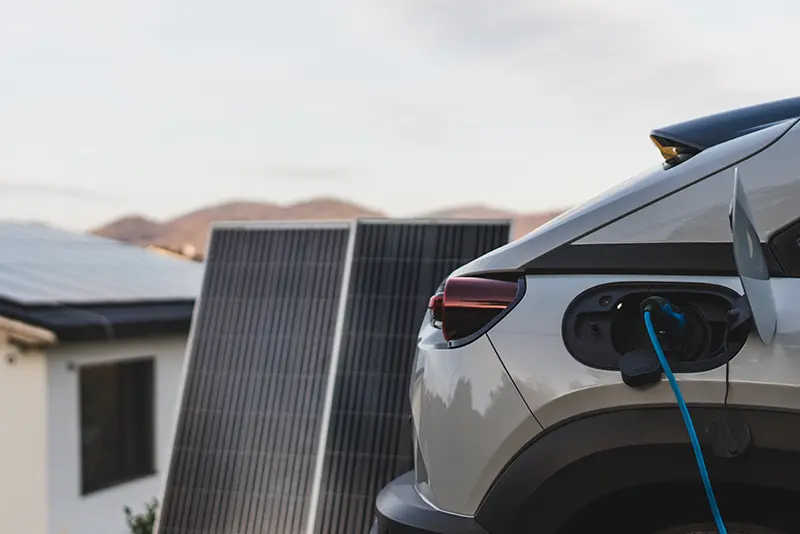
Home EV charger powered by solar panels
Integrating Solar Power with EV Charging
Integrating solar power with your home EV charging setup is a smart way to reduce your reliance on the grid and cut your electricity bills.
A typical system includes solar panels, an inverter, and a home battery storage unit, which work together to capture and store solar energy for use in charging your vehicle.
By pairing your EV charger with a solar power system, you can enjoy the benefits of clean, renewable energy while reducing your overall energy costs. This approach not only supports a greener lifestyle but also enhances the value and sustainability of your home.
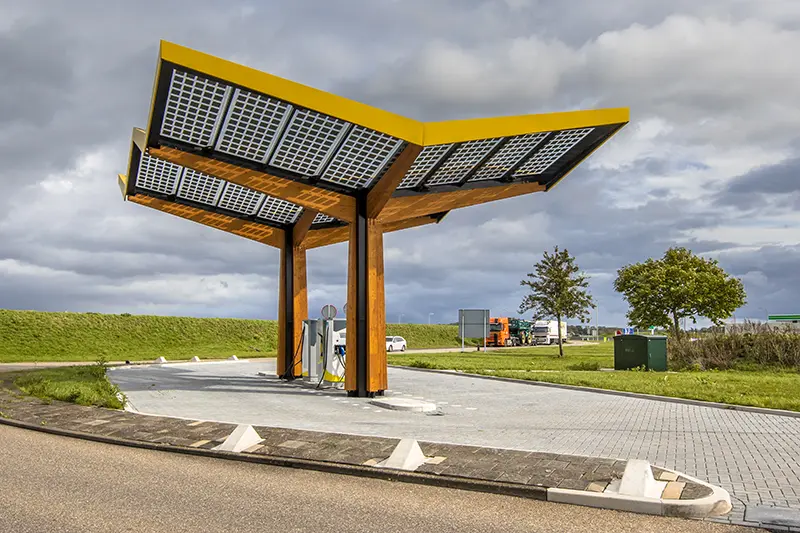
Solar powered EV charging stations, the future?
EV Charging Myths Debunked
There are many myths surrounding EV charging, such as the belief that it’s too expensive or inconvenient. In reality, with the right setup, charging an EV can be easy, affordable, and highly convenient.
Another common myth is that charging takes too long; however, with the availability of home EV chargers and rapid public charging stations, most drivers can easily keep their vehicles charged without significant time investment.
By understanding the facts about EV charging, you can make informed decisions and fully enjoy the benefits of electric vehicle ownership.
Public Charging vs. Home Charging: Which is Better?
Both public and home charging have their own advantages. Home charging is generally more convenient and cost-effective, allowing you to charge your vehicle overnight and take advantage of lower electricity rates. Public charging, on the other hand, is essential for long trips and when home charging isn’t available.
Rapid chargers at public stations can quickly top up your battery, making them a great option for road trips or when you need a quick boost. Ultimately, the best approach is to use a combination of both, depending on your needs and driving habits.
What to Do If You Can’t Charge at Home
If home charging isn’t an option, there are still plenty of ways to keep your EV charged. Consider charging at work, using public charging stations, or even asking a friend or family member if you can use their home charger.
Some areas offer curbside charging for those without off-street parking, providing a convenient solution for apartment dwellers or those in densely populated areas. By planning ahead and exploring all your options, you can ensure that your EV remains fully charged and ready to go, even without a home charger.
The Role of EV Charging in Reducing Emissions
Charging an EV contributes significantly to reducing greenhouse gas emissions, especially when powered by renewable energy sources. Unlike traditional gasoline vehicles, electric cars produce no tailpipe emissions, making them a cleaner alternative for daily transportation.
By charging your EV with solar power or a green energy plan, you can further reduce your environmental impact and contribute to a more sustainable future. As more drivers switch to electric vehicles, the collective reduction in emissions will play a crucial role in combating climate change and improving air quality.
Understanding Time-of-Use Rates for EV Charging
Time-of-use (TOU) rates are electricity pricing plans that charge different rates depending on the time of day. For EV owners, this means you can save money by charging your vehicle during off-peak hours when electricity is cheaper.
Many energy providers offer TOU plans specifically designed for EV charging, making it easier to take advantage of these lower rates. By scheduling your charging sessions for off-peak times, you can significantly reduce your electricity costs while helping to balance the demand on the grid.
How to Avoid Overloading Your Home’s Electrical System
Charging an EV at home requires a significant amount of electricity, and it’s important to ensure your home’s electrical system can handle the load. To avoid overloading your system, consider upgrading your circuit breaker or installing a dedicated circuit for your EV charger.
Additionally, it’s important to spread out your electrical usage throughout the day, avoiding running multiple high-power appliances while charging your vehicle. By taking these precautions, you can ensure safe and efficient charging without risking damage to your home’s electrical infrastructure.
The Importance of Professional Installation for Home Chargers
Professional installation of your home EV charger is crucial for ensuring safety and compliance with local electrical codes. A qualified electrician will assess your home’s electrical system, install the charger securely, and make any necessary upgrades to support the additional load.
This helps prevent potential hazards such as electrical fires or system overloads, providing peace of mind and reliable operation. Investing in professional installation also ensures that your charger performs optimally, delivering efficient and safe charging for your electric vehicle.
Upgrading Your Home’s Electrical System for EV Charging
Depending on your home’s current electrical capacity, you may need to upgrade your electrical system to support a Level 2 charger.
This upgrade might involve installing a new circuit, upgrading your electrical panel, or even increasing your home’s overall power capacity. While these upgrades can add to the cost of installing a home charger, they are essential for safe and efficient charging. By ensuring your home’s electrical system is up to the task, you can enjoy the benefits of faster charging and avoid potential issues down the road.
The Economics of EV Charging: Cost vs. Petrol
While the initial cost of installing a home EV charger can be high, the long-term savings on fuel and maintenance make electric vehicles more economical than petrol-powered cars.
Charging your EV at home typically costs less per mile than filling up a traditional car with petrol, especially when using off-peak electricity rates. Additionally, EVs have fewer moving parts and require less maintenance, further reducing overall costs. When considering the total cost of ownership, electric vehicles offer a more cost-effective solution for the long term.
Battery Swapping: An Alternative to Charging?
Battery swapping is an emerging concept where you exchange your depleted battery for a fully charged one at a specialized station. This process can be quicker than traditional charging, making it an attractive option for long-distance travel or commercial vehicles.
While battery swapping infrastructure is not yet widespread, it has the potential to complement existing charging networks and provide an alternative solution for keeping EVs on the road. As the technology develops, battery swapping could become a viable option for certain types of electric vehicles.
The Role of Government Policies in EV Charging Infrastructure
Government policies and incentives play a crucial role in expanding EV charging infrastructure and encouraging the adoption of electric vehicles. These policies often include grants for installing home and public chargers, tax credits for purchasing EV’s, and funding for research and development of new charging technologies.
By supporting the growth of charging networks and reducing the cost of EV ownership, government policies help accelerate the transition to cleaner transportation and reduce reliance on fossil fuels.
The Future of EV Charging: Trends to Watch
The future of EV charging is set to be shaped by several key trends, including the expansion of ultra-fast charging networks, the adoption of wireless charging, and the integration of EVs with smart grids.
These advancements will make charging faster, more convenient, and more accessible for all drivers. Additionally, as renewable energy sources become more prevalent, the environmental benefits of EV charging will continue to grow. By staying informed about these trends, you can make the most of your EV ownership experience and stay ahead of the curve in this rapidly evolving industry.
The electric car world is evolving at lightning speed, and smart-motoring.com/electric-cars is your one-stop hub for all the updates. From hot new EV releases to game-changing charging networks, our expert coverage will keep you informed and inspired. Plug in and power up your electric car knowledge now!
For more articles like this, receive our weekly e-newsletter, including partner deals and all things motoring, register your email below.
Please note: You cannot subscribe to Smart-Motoring unless you put a tick in the checkbox below to indicate have read and agreed to our privacy policy.


